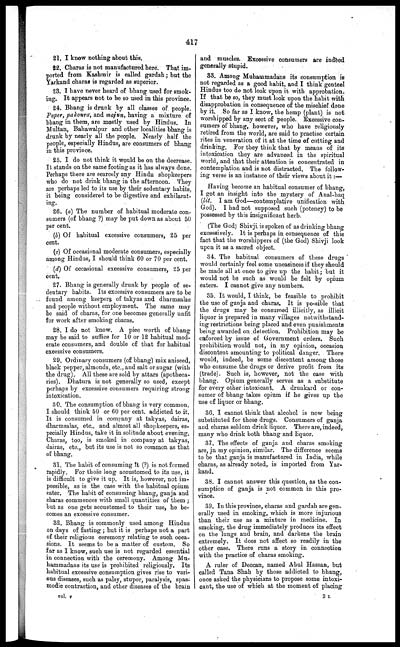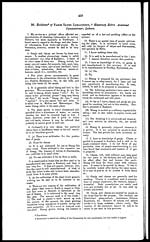Medicine - Drugs > Report of the Indian Hemp Drugs Commission, 1894-1895 > Volume V
(437) Page 417
Download files
Individual page:
Thumbnail gallery: Grid view | List view

417
21. I know nothing about this.
22. Charas is not manufactured here. That im-
ported from Kashmir is called gardah; but the
Yarkand charas is regarded as superior.
23. I have never heard of bhang used for smok-
ing. It appears not to be so used in this province.
24. Bhang is drunk by all classes of people.
Paper, pakoura, and majun, having a mixture of
bhang in them, are mostly used by Hindus. In
Multan, Bahawalpur and other localities bhang is
drunk by nearly all the people. Nearly half the
people, especially Hindus, are consumers of bhang
in this province.
25. I do not think it would be on the decrease.
It stands on the same footing as it has always done.
Perhaps there are scarcely any Hindu shopkeepers
who do not drink bhang in the afternoon. They
are perhaps led to its use by their sedentary habits,
it being considered to be digestive and exhilarat-
ing.
26. (a) The number of habitual moderate con-
sumers (of bhang ?) may be put down as about 50
per cent.
(b) Of habitual excessive consumers, 25 per
cent.
(c) Of occasional moderate consumers, especially
among Hindus, I should think 60 or 70 per cent.
(d) Of occasional excessive consumers, 25 per
cent.
27. Bhang is generally drunk by people of se-
dentary habits. Its excessive cousumers are to be
found among keepers, of takyas and dharmsalas
and people without employment. The same may
be said of charas, for one becomes generally unfit
for work after smoking charas.
28. I do not know. A pice worth of bhang
may be said to suffice for 10 or 12 habitual mod-
erate cousumers, and double of that for habitual
excessive consumers.
29. Ordinary consumers (of bhang) mix aniseed,
black pepper, almonds, etc., and salt or sugar (with
the drug). All these are sold by attars (apotheca-
ries). Dhatura is not generally so used, except
perhaps by excessive consumers requiring strong
intoxication.
30. The consumption of bhang is very common.
I should think 50 or 60 per cent. addicted to it.
It is consumed in company at takyas, dairas,
dharmsalas, etc., and almost all shopkeepers, es-
pecially Hindus, take it in solitude about evening.
Charas, too, is smoked in company at takyas,
dairas, etc., but its use is not so common as that
of bhang.
31. The habit of consuming it (?) is not formed
rapidly. For those long accustomed to its use, it
is difficult to give it up. It is, however, not im-
possible, as is the case with the habitual opium
eater. The habit of consuming bhang, ganja and
charas commences with small quantities of them;
but as one gets accustomed to their use, he be-
comes an excessive consumer.
32. Bhang is commonly used among Hindus
on days of fasting; but it is perhaps not a part
of their religious ceremony relating to such occa-
sions. It seems to be a matter of custom. So
far as I know, such use is not regarded essential
in connection with the ceremony. Among Mu-
hammadans its use is prohibited religiously. Its
habitual excessive consumption gives rise to vari-
ous diseases, such as palsy, stupor, paralysis, spas-
modic contraction, and other diseases of the brain
and muscles. Excessive consumers are indeed
generally stupid.
33. Among Muharomadans its consumption is
not regarded as a good habit, and I think genteel
Hindus too do not look upon it with approbation.
If that be so, they must look upon the habit with
disapprobation in consequence of the mischief done
by it. So far as I know, the hemp (plant) is not
worshipped by any sect of people. Excessive con-
sumers of bhang, however, who have religiously
retired from the world, are said to practise certain
rites in veneration of it at the time of cutting and
drinking. For they think that by means of its
intoxication they are advanced in the spiritual
world, and that their attention is concentrated in
contemplation and is not distracted. The follow-
ing verse is an instance of their views about it:—
Having become an habitual consumer of bhang,
I got an insight into the mystery of Anal-haq
(lit. I am God—contemplative unification with
God). I had not supposed such (potency) to be
possessed by this insignificant herb.
(The God) Shivji is spoken of as drinking bhang
excessively. It is perhaps in consequence of this
fact that the worshippers of (the God) Shivji look
upon it as a sacred object.
34. The habitual consumers of these drugs
would certainly feel some uneasiness if they should
be made all at once to give up the habit; but it
would not be such as would be felt by opium
eaters. I cannot give any numbers.
35. It would, I think, be feasible to prohibit
the use of ganja and charas. It is possible that
the drugs may be consumed illicitly, as illicit
liquor is prepared in many villages notwithstand-
ing restrictions being placed and even punishments
being awarded on detection. Prohibition may be
enforced by issue of Government orders. Such
prohibition would not, in my opinion, occasion
discontent amounting to political danger. There
would, indeed, be some discontent among those
who consume the drugs or derive profit from its
(trade). Such is, however, not the case with
bhang. Opium generally serves as a substitute
for every other intoxicant. A drunkard or con-
sumer of bhang takes opium if he gives up the
use of liquor or bhang.
36. I cannot think that alcohol is now being
substituted for these drugs. Consumers of ganja
and charas seldom drink liquor. There are, indeed,
many who drink both bhang and liquor.
37. The effects of ganja and charas smoking
are, in my opinion, similar. The difference seems
to be that ganja is manufactured in India, while
charas, as already noted, is imported from Yar-
kand.
38. I cannot answer this question, as the con-
sumption of ganja is not common in this pro-
vince.
39. In this province, charas and gardah are gen-
erally used in smoking, which is more injurious
than their use as a mixture in medicine. In
smoking, the drug immediately produces its effect
on the lungs and brain, and darkens the brain
extremely. It does not affect so readily in the
other case. There runs a story in connection
with the practice of charas smoking.
A ruler of Deccan, named Abul Hassan, but
called Tana Shah by those addicted to bhang,
once asked the physicians to propose some intoxi-
cant, the use of which at the moment of placing
vol. v. 3 L
Set display mode to: Large image | Zoom image | Transcription
Images and transcriptions on this page, including medium image downloads, may be used under the Creative Commons Attribution 4.0 International Licence unless otherwise stated. ![]()
| India Papers > Medicine - Drugs > Report of the Indian Hemp Drugs Commission, 1894-1895 > Volume V > (437) Page 417 |
|---|
| Permanent URL | https://digital.nls.uk/75122159 |
|---|
| Description | Volume 5: Evidence of witnesses from North-Western Provinces and Oudh and Punjab. Answers from witnesses in North-Western Provinces, Oudh and Punjab about cultivation and growth of hemp, preparation or manufacture, trade, consumption or use, effects, administration - taxation and control. |
|---|---|
| Attribution and copyright: |
|




